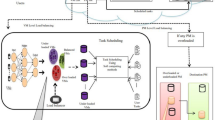Abstract
Artificial neural networks (ANN), fuzzy inference systems, approximate reasoning, and derivative-free optimization approaches like evolutionary computation, among others, are all components of Soft Computing (SC), an innovative method for building computationally intelligent methods. Due to its widespread use and benefits, cloud computing is currently a major focus for researchers. The distributed nature of cloud computing and its complete reliance on the internet for service provision present security challenges, the most serious of which is insider Distributed Denial of Service (DDoS) which results in complete deactivation of services. Based on machine learning and the cloud, this study proposes a novel method for improving computing network security. Using a trust-based secure cloud environment and the Kernel principal component encoder architecture, the network monitoring is carried out. The soft computing environment-based detection of a cyberattack on the network is the purpose for the security enhancement. Throughput, QoS, latency, and packet delivery ratio for various monitored cyber security datasets are the focus of the experimental analysis. The proposed technique attained network security analysis of 89%, throughput of 98%, QoS of 66%, latency of 59%, packet delivery ratio of 83%.









Similar content being viewed by others
Data availability
Enquiries about data availability should be directed to the authors.
References
Achar S (2022) Adopting artificial intelligence and deep learning techniques in cloud computing for operational efficiency. Int J Inf Commun Eng 16(12):567–572
Alani MM, Tawfik H (2022) PhishNot: a cloud-based machine-learning approach to phishing URL detection. Comput Netw 218:109407
Arunkumar M, Ashok Kumar K (2022) Malicious attack detection approach in cloud computing using machine learning techniques. Soft Comput 26(23):13097–13107
Guezzaz A, Azrour M, Benkirane S, Mohyeddine M, Attou H, Douiba M (2022) A lightweight hybrid intrusion detection framework using machine learning for edge-based IIoT security. Int Arab J Inf Technol 19(5)
Gupta R, Singh AK (2022) A differential approach for data and classification service-based privacy-preserving machine learning model in cloud environment. N Gener Comput 40(3):737–764
Jain R, Bekuma Y, Pattanaik B, Assebe A, Bayisa T (2022) Design of a smart wireless home automation system using fusion of iot and machine learning over cloud environment. In: 2022 3rd international conference on intelligent engineering and management (ICIEM), pp 840–847. IEEE
Kanagala P (2023) Effective cyber security system to secure optical data based on deep learning approach for healthcare application. Optik 272:170315
Kumar Y, Kaul S, Hu YC (2022a) Machine learning for energy-resource allocation, workflow scheduling and live migration in cloud computing: state-of-the-art survey. Sustain Comput Inf Syst 36:100780
Kumar A, Umurzoqovich RS, Duong ND, Kanani P, Kuppusamy A, Praneesh M, Hieu MN (2022b) An intrusion identification and prevention for cloud computing: from the perspective of deep learning. Optik 270:170044
Lira LAN, Kumari KA, Raman R, Kurniullah AZ, Morales SAG, Cordero TDCE (2022) Data security enhancement in 4G vehicular networks based on reinforcement learning for satellite edge computing. Int J Commun Netw Inf Secur 14(3):59–72
Mawgoud AA, Taha MHN, Kotb A (2022) Steganography adaptation model for data security enhancement in ad-hoc cloud based V-BOINC through deep learning. In: The 8th international conference on advanced machine learning and technologies and applications (AMLTA2022), pp 68–77. Springer International Publishing, Cham
Mayuranathan M, Saravanan SK, Muthusenthil B, Samydurai A (2022) An efficient optimal security system for intrusion detection in cloud computing environment using hybrid deep learning technique. Adv Eng Softw 173:103236
Milić SD, Đurović Ž, Stojanović MD (2023) Data science and machine learning in the IIoT concepts of power plants. Int J Electr Power Energy Syst 145:108711
Pandey NK, Diwakar M, Shankar A, Singh P, Khosravi MR, Kumar V (2022) Energy efficiency strategy for big data in cloud environment using deep reinforcement learning. Mobile Inf Syst 2022
Prabhu RS, Prema A, Perumal E (2022) A novel cloud security enhancement scheme to defend against DDoS attacks by using deep learning strategy. In: 2022 6th international conference on electronics, communication and aerospace technology, pp 698–704. IEEE
Raviprasad B, Mohan CR, Devi GNR, Pugalenthi R, Manikandan LC, Ponnusamy S (2022) Accuracy determination using deep learning technique in cloud-based IoT sensor environment. Meas Sens 24:100459
Roshan K, Zafar A (2022) A systematic review of deep learning approaches for computer network and information security. High Perform Comput Netw Select Proc CHSN 2021:345–356
Sambangi S, Gondi L, Aljawarneh S (2022) A feature similarity machine learning model for ddos attack detection in modern network environments for industry 4.0. Comput Electr Eng 100:107955
Sharma A, Singh UK (2022) Modelling of smart risk assessment approach for cloud computing environment using AI & supervised machine learning algorithms. Global Trans Proc 3(1):243–250
Singh G, Khare N (2022) A survey of intrusion detection from the perspective of intrusion datasets and machine learning techniques. Int J Comput Appl 44(7):659–669
Waqas M, Kumar K, Laghari AA, Saeed U, Rind MM, Shaikh AA, Qazi AQ (2022) Botnet attack detection in internet of things devices over cloud environment via machine learning. Concurr Comput Pract Exp 34(4):e6662
Funding
This research is not supported by any Government or Non-Government Organization.
Author information
Authors and Affiliations
Corresponding author
Ethics declarations
Conflict of interest
All authors declare no conflict of Interest.
Ethical approval
This article does not contain any studies with animals performed by any of the authors.
Additional information
Publisher's Note
Springer Nature remains neutral with regard to jurisdictional claims in published maps and institutional affiliations.
Rights and permissions
Springer Nature or its licensor (e.g. a society or other partner) holds exclusive rights to this article under a publishing agreement with the author(s) or other rightsholder(s); author self-archiving of the accepted manuscript version of this article is solely governed by the terms of such publishing agreement and applicable law.
About this article
Cite this article
Thomas, M., Gupta, M.V., Gokul Rajan, V. et al. Soft computing in computer network security protection system with machine learning based on level protection in the cloud environment. Soft Comput (2023). https://doi.org/10.1007/s00500-023-08395-3
Accepted:
Published:
DOI: https://doi.org/10.1007/s00500-023-08395-3




